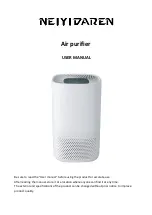
14
Climate 5000 – 6720886909 (2018/04)
Outdoor Unit Installation
If refrigerant piping is already embedded in the wall,
do the following:
1. Hook the top of the indoor unit on the upper hook of the mounting
plate.
2. Use a bracket or wedge to prop up the unit, giving you enough room
to connect the refrigerant piping, signal cable and drain hose. Refer
to
Fig. 18
for an example.
Wedge
Fig. 18.
3. Connect drain hose and refrigerant piping (refer to
Refrigerant
Piping Connection
section of this manual for instructions).
4. Keep pipe connection point exposed to perform the leak test (refer
to
Electrical Checks and Leak Checks
section of this manual).
5. After the leak test, wrap the connection point with insulation tape.
6. Remove the bracket or wedge that is propping up the unit.
7. Using even pressure, push down on the bottom half of the unit. Keep
pushing down until the unit snaps onto the hooks along the bottom
of the mounting plate.
Unit is adjustable
Keep in mind that the hooks on the mounting plate are smaller than the
holes on the back of the unit. If you find that you do not have ample room
to connect embedded pipes to the indoor unit, the unit can be adjusted
left or right by about 30-50mm, depending on the model. (See
Fig. 19
.)
30-50mm
30-50mm
Move to left or right
Fig. 19.
6
Outdoor Unit Installation
Fig. 20.
Installation Instructions – Outdoor Unit
1.9
Step 1: Select installation location
Before installing the outdoor unit, you must choose an appropriate
location. The following are standards that will help you choose an
appropriate location for the unit.
Proper installation locations meet the following standards:
f
Meets all requirements shown in Installation Space (
Fig. 21
)
f
Good air circulation and ventilation
f
Firm and solid base — the location can support the unit and will not
vibrate
f
Noise from the unit will not disturb others
f
Protected from prolonged periods of direct sunlight or rain
60cm abo
ve
30cm fr
om bac
k w
all
200cm in fr
ont
30cm on lef
t
60cm on r
ight
Fig. 21.
DO NOT install unit in the following locations:
Near an obstacle that will block air inlets and outlets
Near a public street, crowded areas or where noise from the unit will
disturb others
Near animals or plants that will be harmed by hot air discharge
Near any source of combustible gas
In a location that is exposed to large amounts of dust
In a location exposed to excessive amounts of salty air (coastal area)














































